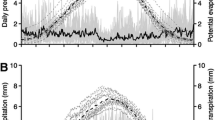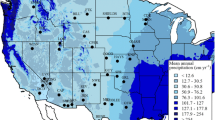Abstract
Water availability defines and is the most frequent control on processes in arid and semiarid ecosystems. Despite widespread recognition of the importance of water in dry areas, knowledge about key processes in the water balance is surprisingly limited. How water is partitioned between evaporation and transpiration is an area about which ecosystem ecologists have almost no information. We used a daily time step soil water model and 39 years of data to describe the ecohydrology of a shortgrass steppe and investigate how manipulation of soil and vegetation variables influenced the partitioning of water loss between evaporation and transpiration. Our results emphasize the overwhelming importance of two environmental factors in influencing water balance processes in the semiarid shortgrass steppe; high and relatively constant evaporative demand of the atmosphere and a low and highly variable precipitation regime. These factors explain the temporal dominance of dry soil. Annually and during the growing season 60–80% of the days have soil water potentials less than or equal to −1.5 MPa. In the 0–15 cm layer, evaporation accounts for half of total water loss and at 15–30 cm it accounts for one third of the loss. Annual transpiration/actual evapotranspiration (T/AET) ranged from 0.4–0.75 with a mean of 0.51. The key controls on both T/AET and evaporation/actual evapotranspiration in order of their importance were aboveground biomass, seasonality of biomass, soil texture, and precipitation. High amounts of biomass and late timing of the peak resulted in the highest values of T/AET.









Similar content being viewed by others
References
Bailey HP. 1979. Semi-arid climates: their definition and distribution. In: Hall AE, Cannell GH, Lawton HW, Eds. Agriculture in semiarid environments. Ecological studies 34, Berlin: Springer, pp 73–97
Branson FA, Gifford GF, Renard KG, Hadley RF. 1981. Rangeland hydrology. Toronto: Kendall/Hunt Publishing Co., 340 p
Burke IC, Lauenroth WK, Parton WJ. 1997. Regional and temporal variation in aboveground net primary production and net nitrogen mineralization in grasslands. Ecology 78:1330–40
Canham CD, Cole JJ, Lauenroth WK, Eds. 2003. Models in ecosystem science. Princeton (NJ): Princeton University Press. 476 p
Coffin DP, Lauenroth WK, Burke IC. 1993. Spatial dynamics in the recovery of shortgrass steppe ecosystems. In: Gardner R, Ed. Spatial processes in ecological systems. Providence: American Mathematical Society, pp 75–108
De Jong R, Hayhoe HN. 1984. Diffusion-based soil water simulation for native grassland. Agric Water Manage 9:47–60
Dodd MB, Lauenroth WK. 1997. The influence of soil texture on the soil water dynamics and vegetation characteristics of a shortgrass steppe ecosystem. Plant Ecol 133:13–28
Ehleringer JR, Roden J, Dawson TE. 2000. Assessing ecosystem-level water relations through stable isotope ratio analyses. In: Sala OE, Jackson RB, Mooney HA, Howarth RW, Eds. Methods in ecosystem science. New York: Springer, pp 181–98
Epstein HE, Burke IC, Lauenroth WK. 2002. Regional patterns of decomposition and primary production rates in the U.S. Great Plains. Ecology 83:320–7
Falkenmark M. 1989. Comparative hydrology – a new concept. In: Falkenmark M, Chapman T, Eds. pp 10-42, Paris: UNESCO, 479 p
Ferretti DF, Pendall E, Morgan JA, Nelson JA, LeCain D, Mosier AR. 2003. Partitioning evapotranspiration fluxes from a Colorado grassland using stable isotopes: seasonal variations and ecosystem implications of elevated atmospheric CO2. Plant Soil 254:291–303
Floret C, Pontanier R, Rambal S.1982. Measurement and modeling of primary production and water use in a south Tunisian steppe. J Arid Environ 5:77–90
Lauenroth WK. 1979. Grassland primary production: North American grasslands in perspective. Chapter I. In: French NR, Ed. Perspectives in grassland ecology. Ecological studies, vol. 32. New York: Springer
Lauenroth WK, Milchunas DG. 1992. The shortgrass steppe. In: Coupland RT, Ed. Natural grasslands. vol. 8a. Ecosystems of the world. Amsterdam: Elsevier
Lauenroth WK, Sala OE. 1992. Long term forage production of North American shortgrass steppe. Ecol Appl 2:397–403
Lauenroth WK, Urban DL, Coffin DP, Parton WJ, Shugart HH, Kirchner TB, Smith TM. 1993. Modeling vegetation structure-ecosystem process interactions across sites and ecosystems. Ecol Modell 67:49–80
Lauenroth WK, Sala OE, Coffin DP, Kirchner TB. 1994. Recruitment of Bouteloua gracilis in the shortgrass steppe: a simulation analysis of the role of soil water. Ecol Appl 4:741–9
Liang Y, Hazlett DL, Lauenroth WK. 1989. Water use efficiency of five plant communities in the shortgrass steppe. Oecologia (Berl.) 80:148–53
Milchunas DG, Lauenroth WK, Chapman PL, Kazempour MK. 1989. Effects of grazing, topography, and precipitation on the structure of a semiarid grassland. Vegetatio 80:11–23
Ng E, Miller PC.1980. Soil moisture relations in the southern California chaparral. Ecology 61:98–107
Noy-Meir I 1973. Desert ecosystems: environment and producers. Ann Rev Ecol Syst 4:25–52
Parton WJ. 1978. Abiotic section of ELM. In: Innis GS, Ed. pp 31–54, Grassland simulation model. Ecological Studies 26, New York: Springer, 298 p
Paruelo JM, Sala OE. 1995. Water losses in the Patagonian steppe – a modeling approach. Ecology 76:510–20
Reynolds JF, Kemp PR, Tenhunen JD. 2000. Effects of long-term rainfall variability on evapotranspiration and soil water distribution in the Chihuahuan Desert: A modeling analysis. Plant Ecol 150:145–59
Ripley EA. 1992. Water flow. In: Coupland RT, Ed. Natural grasslands: introduction and western hemisphere. Ecosystems of the world 8A. Amsterdam: Elsevier, pp 55–73
Sala OE, Lauenroth WK. 1982. Small rainfall events: an ecological role in semiarid regions. Oecologia (Berl.) 53:301–4
Sala OE, Lauenroth WK. 1985. Root profiles and the ecological effect of light rain showers in arid and semiarid regions. Am Midl Nat 114:406–8
Sala OE, Parton WJ, Joyce LA, Lauenroth WK. 1988. Primary production of the central grassland region of the United States: spatial pattern and major controls. Ecology 69:40–5
Sala OE, Lauenroth WK, Parton WJ. 1992. Long term soil water dynamics in the shortgrass steppe. Ecology 73:1175–81
Schwinning S, Sala OE, Loik ME, Ehleringer JR. 2004. Thresholds, memory, and seasonality: understanding pulse dynamics in arid/semi-arid ecosystems. Oecologia 141:191–3
Shugart HH. 2000. Ecosystem modeling. In: Sala OE, Jackson RB, Mooney HA, Howarth RW, Eds. Methods in ecosystem science. New York: Springer, pp 373–88
Shultz J. 1995. The ecozones of the world. Berlin: Springer, 449 p
Sims PL, Singh JS, Lauenroth WK. 1978. The structure and function of ten western North American grasslands. I. Abiotic and vegetational characteristics. J Ecol 66:251–85
Steinhorst RK, Hunt HW, Innis GS, Haydock KP.1978. Sensitivity analyses of the ELM model. In: Innis GS, Ed. Grassland simulation model. Ecological Studies 26, New York: Springer, pp 231–56
Walter H. 1971. Natural savannas: ecology of tropical and subtropical vegetation. Oliver and Boyd
Wight JR, Hanson CL, Cooley KR. 1986. Modeing evapotranspiration from sagebrush grass rangeland. J Range Manage 39:81–5
Wythers KR, Lauenroth WK, Paruelo JM. 1999. Bare-soil evaporation under semiarid field conditions. Soil Sci Soc Am J 63:1341–9
Yonker CM, Schimel DS, Paroussis E, Heil RD. 1988. Patterns of organic carbon accumulation in a semiarid shortgrass steppe, Colorado. Soil Sci Soc Am J 52:478–83
Author information
Authors and Affiliations
Corresponding author
APPENDIX
APPENDIX
Rights and permissions
About this article
Cite this article
Lauenroth, W.K., Bradford, J.B. Ecohydrology and the Partitioning AET Between Transpiration and Evaporation in a Semiarid Steppe. Ecosystems 9, 756–767 (2006). https://doi.org/10.1007/s10021-006-0063-8
Received:
Accepted:
Published:
Issue Date:
DOI: https://doi.org/10.1007/s10021-006-0063-8




